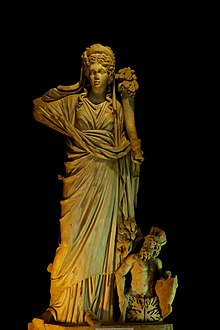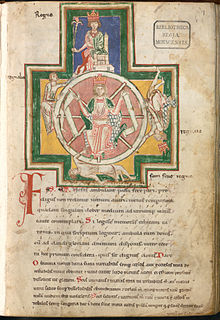Fortuna

Fortuna (Latin "luck", "fate"; Fors Fortuna: "power of fate"; nickname Antias ) is the goddess of luck and fate in Roman mythology , she corresponds to the Tyche in Greek mythology and salvation among the ancient Norse peoples.
Antiquity
Presumably, the goddess was popularized by King Servius Tullius at the beginning of the Roman Empire . Tullius is said to have dedicated twenty-six temples to Fortuna , each with a different epicle . According to legend, he came to the royal throne as the son of a slave through the favor of the goddess of fate. Fortuna later played an important role in the religion of the Romans, among other things she is mentioned as one of the Parzen . Many temples throughout the Roman Empire were dedicated to her (e.g. the temple of Fortuna Euelpis ). Well-known temples of Fortuna were in Antium , from which she got her nickname Antias , in Praeneste and on the Quirinal , one of the seven hills of Rome . Their festival was celebrated on June 24th . Fortuna was by the Romans as a state goddess ( Fortuna Populi Romani ) and as a private goddess ( Fortuna privata worshiped).
Middle Ages and Modern Times


Starting with the monastery schools, people began to see Fortuna and the goddess Natura as servants of God in the 12th century. Although this idea was actually incompatible with the Christian faith, it migrated to the newly founded universities in the 13th century. Philosophically trained minds, however, often remained critical of this view.
Fortuna is generally characterized as a fickle, complex goddess who distributes the gifts of her cornucopia , good and bad fate , luck and misfortune, without regard to the person (similar to Justice in that respect ). Her initial religious significance as the goddess of fertility was later superseded by aspects of happiness and fate, which also appear in connection with the medieval motif of vanitas , iconographically in the image of the wheel of life . As the oracle goddess , Fortuna was often asked about the future, often by drawing lots, small pieces of wood with incised lines, which were interpreted by the priesthood. In the tarot sheet X Wheel of Fate , a female figure with a wheel is often shown, which can be interpreted as the goddess Fortuna.
Fortuna was also a popular motif on tokens or tokens in gambling in the 18th and 19th centuries.
In the fine arts , Fortuna is often represented with significant attributes , the wheel of life or fortune , a cornucopia , a rudder or rolling on a ball .
In 1935/36 the composer Carl Orff dedicated the first and the last part of his Carmina Burana to her; the text Fortuna Imperatrix Mundi (German Fortuna, the mistress of the world ) from the collection of the same name from the 13th century begins with:
- O Fortuna,
- velut luna
- statu variabilis ...
- (O Fortuna, like the moon so changeable ...).
The second song begins with:
- Fortune plango vulnera ...
- (The wounds that Fortuna inflicted ...).
In the 18th century the chamberlain Ignatius gave himself the surname Fortuna .
The coat of arms of Glückstadt shows an unclothed Fortuna .
Fortuna is also a popular club name for sports clubs and is often used as a short form for the entire club , especially in football .
swell
literature
- Rudolf Peter with an addendum by Wilhelm Drexler : Fortuna . In: Wilhelm Heinrich Roscher (Hrsg.): Detailed lexicon of Greek and Roman mythology . Volume 1, 2, Leipzig 1890, Sp. 1503–1558 ( digitized version ).
- Thomas Ganschow: Fortuna . In: Lexicon Iconographicum Mythologiae Classicae (LIMC). Volume VIII, Zurich / Munich 1997, pp. 585-591.
- Fritz Graf : Fortuna. In: The New Pauly (DNP). Volume 4, Metzler, Stuttgart 1998, ISBN 3-476-01474-6 , Sp. 598-602.
- Sibylle Appuhn-Radtke: Fortuna . In: Reallexikon zur Deutschen Kunstgeschichte , Vol. X (2005), Sp. 271–401.
- Iiro Kajanto: Fortuna. In: Wolfgang Haase (ed.): Rise and decline of the Roman world. Part II, Vol. 17.1. de Gruyter, Berlin & New York 1981.
- Ehrengard Meyer-Landrut: Fortuna. The goddess of luck through the ages. German art publisher. Munich / Berlin 1997, ISBN 3-422-06207-6 .
- Klaus Reichert : Fortuna or the persistence of change . Suhrkamp, Frankfurt am Main 1985, ISBN 3-518-57729-8 . Covers the reception of Fortuna in England during the Elizabethan era.
Web links
Individual evidence
- ↑ Ludwig Preller: Roman mythology . Weidmannsche Buchhandlung, 1858 ( full text in the Google book search).
- ↑ Vollmer: Dictionary of Mythology , Stuttgart 1874
- ↑ Eduard Gerhard: Greek Mythology, Volume 2 . Printed and published by Georg Reimer, 1855 ( full text in the Google book search).
- ^ Herder Lexicon. Greek and Roman mythology. Herder Verlag, Freiburg im Breisgau, 1981, ISBN 3-451-04343-2 , p. 78
